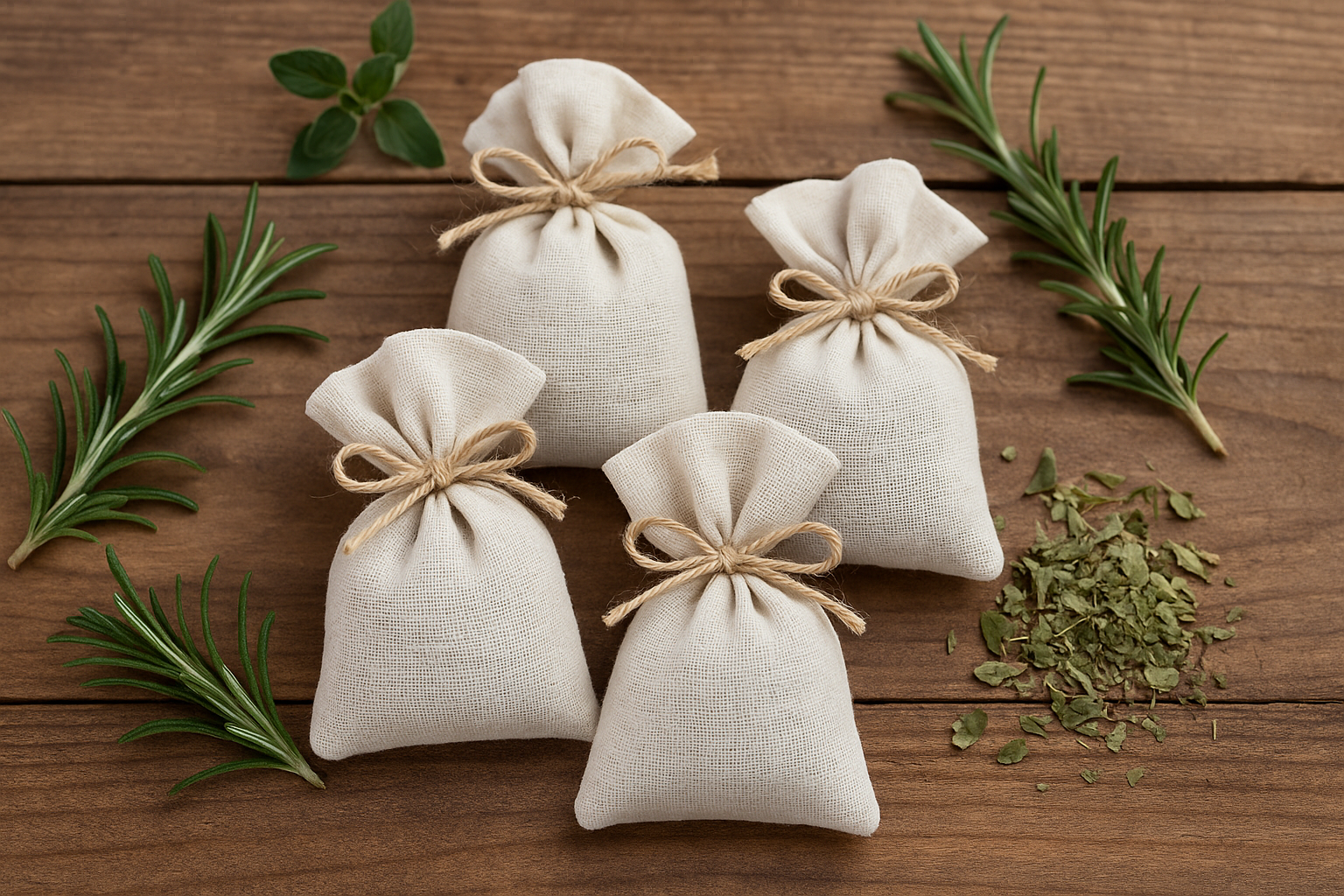Closets and drawers often trap stale odors, especially when air circulation is limited. Instead of relying on chemical sprays or artificial scents, herbal sachets offer a natural, eco-friendly solution.
With just a few simple ingredients, you can create sachets that refresh clothing, linens, and personal spaces while adding a touch of tradition to your home.
Herbal sachets are inexpensive, customizable, and long-lasting. They combine the beauty of natural fragrance with the satisfaction of crafting something useful with your own hands.
Why Choose Herbal Sachets Over Synthetic Fresheners
Synthetic air fresheners often rely on chemical compounds that may irritate sensitive skin or leave overwhelming scents on clothing. Herbal sachets, by contrast, are gentle, safe, and sustainable.
They not only mask odors but also absorb excess moisture, repel insects, and infuse fabrics with subtle natural aromas. For centuries, people around the world have used dried herbs to preserve clothes and create pleasant living environments.
The Best Herbs for Sachets
Choosing the right herbs is key to crafting effective sachets. Some are known for fragrance, others for protective qualities.
- Lavender: Calming, floral, and excellent at repelling moths.
- Rosemary: Sharp and refreshing, keeps closets smelling clean.
- Mint: Adds a cooling, fresh scent while discouraging insects.
- Lemon balm: Soft citrus fragrance that calms the mind.
- Sage: Earthy and cleansing, traditionally used for purification.
- Marcela: Popular in Southern Brazil, offers a golden, soothing aroma.
These herbs can be blended for layered fragrances or used alone for simplicity.
Adding Citrus for Extra Freshness
Citrus peels such as orange, lemon, or tangerine can be dried and added to sachets. They provide a bright, uplifting scent and enhance the freshness of herbs.
To prepare citrus, peel the fruit, cut the skin into thin strips, and dry them in a warm, ventilated place until crisp. The dried pieces hold their fragrance for months and pair beautifully with herbs like lavender or rosemary.
Choosing the Right Fabric for Sachets
The fabric you choose matters. It must be breathable so that fragrance can escape, while still protecting the herbs inside. Cotton, linen, and muslin are ideal.
You can upcycle old fabric scraps, handkerchiefs, or pillowcases. Choosing colorful prints adds charm to your sachets, while neutral fabrics blend discreetly with clothing.
Basic Method to Make Herbal Sachets
Creating sachets is simple and requires only a few steps:
- Cut fabric into small squares or rectangles, about 10–12 cm wide.
- Place a handful of dried herbs or a mixture of herbs and citrus peels in the center.
- Fold the fabric and sew the edges, leaving a small opening.
- Fill the sachet fully, then stitch the final seam.
If sewing is not your style, tie fabric squares with ribbons or strings for a rustic look.
Creative Sachet Designs
Herbal sachets don’t need to be plain. They can be decorative as well as functional.
- Ribbon ties: Add satin ribbons for elegance.
- Lace overlay: Place lace over plain fabric for a vintage feel.
- Stamped fabric: Use natural dyes or stamps to personalize sachets with patterns.
These details make sachets thoughtful gifts as well as practical household items.
Where to Place Sachets
Herbal sachets can freshen many areas of the home:
- Closets: Hang them on hangers or place them in storage bins.
- Drawers: Tuck them between folded clothes or linens.
- Shoes: Slip small sachets into footwear to absorb odors.
- Suitcases: Add one when traveling to keep luggage fresh.
Placing sachets strategically ensures fragrance is distributed evenly.
Refreshing and Maintaining Sachets
Over time, sachets lose intensity. To refresh them, gently squeeze or shake the sachet to release trapped oils from the herbs. You can also add a drop or two of essential oil directly onto the fabric.
Sachets typically last three to six months, depending on the herbs used. When fragrance fades completely, simply replace the contents with a new herbal blend.
Herbal Sachets for Different Purposes
Not all sachets are designed the same. Some blends are crafted for specific purposes:
- Relaxation sachets: Lavender and lemon balm, ideal for bedroom drawers.
- Energy sachets: Mint and rosemary, perfect for office spaces or closets.
- Protective sachets: Sage and marcela, connected to traditional cleansing practices.
By tailoring blends, you can design sachets that match both functional needs and personal preferences.
Herbal Sachets in Gaúcho Tradition
In Southern Brazil, families have long valued herbs like rosemary and marcela for their cultural significance. Placing bundles in closets or drawers was not only about fragrance but also about protection and symbolism.
DIY sachets bring a modern twist to this heritage, allowing traditional plants to be used in practical and creative ways.
Eco-Friendly and Zero-Waste Advantages
Herbal sachets contribute to a sustainable lifestyle. They reduce the need for disposable chemical air fresheners and repurpose natural resources. Using leftover fabric scraps also minimizes waste.
Even when sachets reach the end of their life, the contents can be composted, returning nutrients to the soil. This circular approach aligns with eco-friendly living.
Gifting Herbal Sachets
Handmade sachets make meaningful gifts. They show care, creativity, and an appreciation for natural living. Personalized blends can be tailored to a friend’s preferences, making the gift unique.
Pair sachets with homemade candles or teas to create wellness baskets. Such gifts are budget-friendly yet thoughtful.
Teaching Kids About Nature With Sachets
DIY sachets are excellent projects for children. They can learn about herbs, scents, and sustainable living while practicing simple sewing or tying skills.
Encouraging kids to choose herbs by smell also develops sensory awareness. It turns crafting into both a fun and educational experience.
Combining Sachets With Other Natural Fresheners
Sachets work beautifully alongside other natural methods. Use them with homemade sprays, citrus simmer pots, or herbal candles to layer scents throughout the home.
By combining methods, you create a holistic environment filled with natural fragrances that enhance comfort and mood.
Common Mistakes to Avoid
While sachets are simple to make, some errors can reduce their effectiveness:
- Using herbs that are not fully dried, which can cause mold.
- Choosing fabrics that are too thick, blocking fragrance release.
- Overfilling sachets, making them bulky and hard to place.
Avoiding these mistakes ensures your sachets remain effective and long-lasting.
Herbal Sachets in Modern Wellness Trends
Herbal sachets align with global interest in natural wellness and sustainable living. They combine aromatherapy with eco-friendly practices, making them popular in homes seeking balance and simplicity.
What was once a traditional household habit now fits into a modern lifestyle focused on mindfulness and environmental responsibility.
Final Thoughts
Herbal sachets are more than fragrant pouches. They are small but powerful tools that connect us to nature, preserve traditions, and promote sustainability.
By blending herbs, citrus, and fabric, you create items that refresh your home while reducing dependence on chemicals. Whether tucked into drawers, given as gifts, or crafted with children, sachets bring warmth and natural beauty into everyday life.
With each handmade sachet, you preserve heritage and embrace eco-friendly living, proving that the simplest solutions are often the most enduring.

Marcela Cardozo is passionate about Southern Brazilian traditions and the cultural stories carried through natural scents. She blends knowledge of native herbs, essential oils, and regional rituals to create practical and inspiring content. Her writing connects ancestral wisdom with modern living, offering readers simple ways to bring authenticity, well-being, and meaning into their everyday lives.
